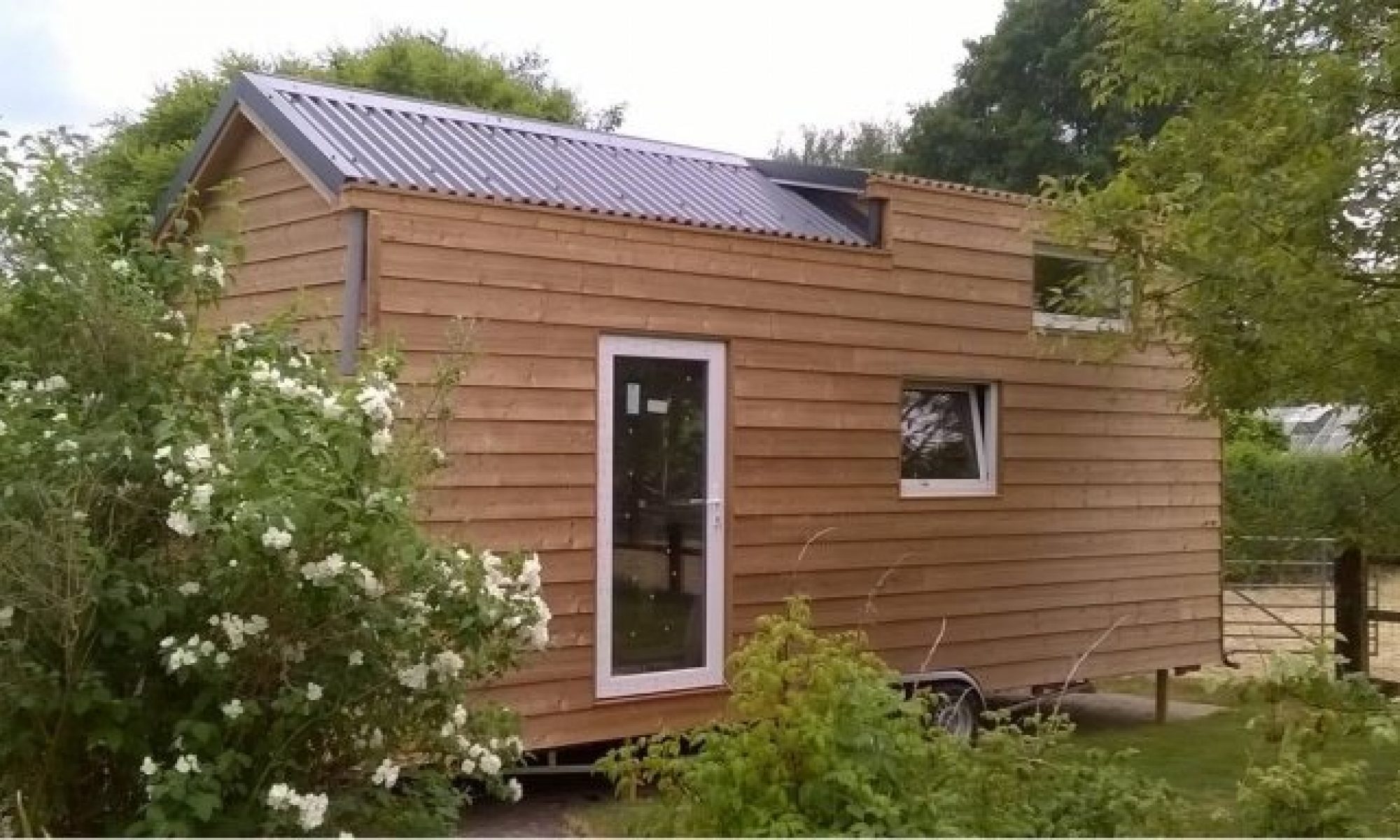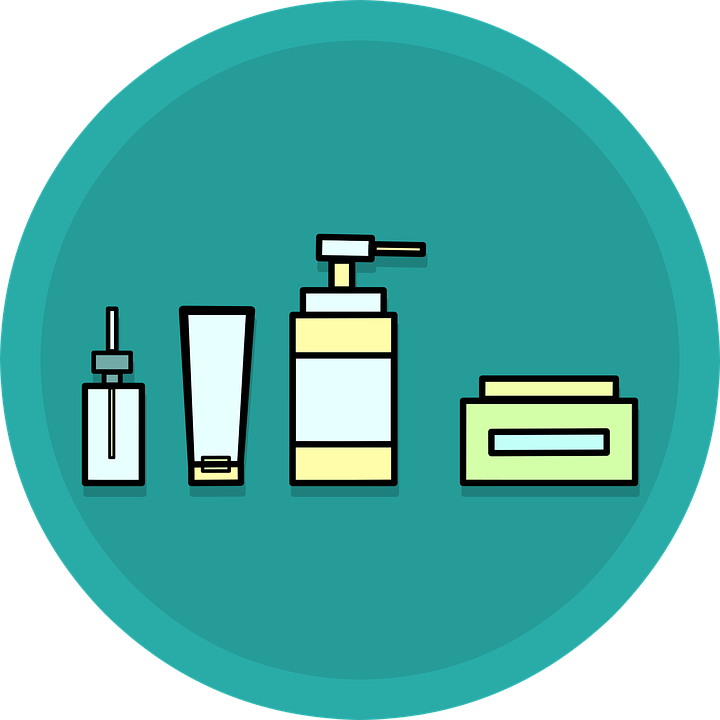Lees dit artikel in het Nederlands:
We don’t think about this very often, but in the bathroom we produce a lot of waste: used cotton swabs, old toothbrushes (or electric toothbrush heads), sanitary towels, tampons, empty packages of toothpaste, shampoo, (shower) soap ,. ..
Also in the bathroom you can think of many alternatives!
-
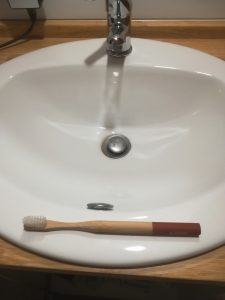 Bamboo toothbrush. I recently bought a toothbrush made of bamboo. Bamboo is completely biodegradable so you don’t have to throw the toothbrush in the dustbin (like its plastic brothers and sisters) but in the compost bin. The hairs are also made of a material that is biodegradable. So easy! It takes a moment to gett used to it because the texture feels different, when the back of the brush goes along the inside of your cheek, when brushing. But otherwise there is nothing special about it.
Bamboo toothbrush. I recently bought a toothbrush made of bamboo. Bamboo is completely biodegradable so you don’t have to throw the toothbrush in the dustbin (like its plastic brothers and sisters) but in the compost bin. The hairs are also made of a material that is biodegradable. So easy! It takes a moment to gett used to it because the texture feels different, when the back of the brush goes along the inside of your cheek, when brushing. But otherwise there is nothing special about it.- Solid toothpaste (toothpaste bar). The annoying thing about toothpaste is that it always comes in a plastic tube. That means more waste. And in addition, there is also a lot of toothpaste left in the tube, when you throw it away, because you can’t gett it all out. Meanwhile, there is a special alternative: solid toothpaste.
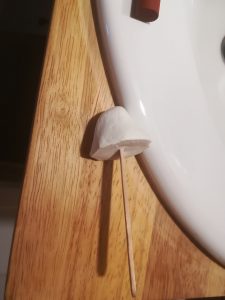 This is a block of toothpaste on a wooden spatula. This toothpaste is mainly made from coconut oil, sodium bicarbonate and an essential oil to add a scent. That smell, however, evaporates quickly, which is a shame. To use the toothpaste, wet your toothbrush with warm water and spin in circles with your brush on the block of toothpaste. And now brush! When you’ve used all the toothpaste, you throw the wooden stick in the compost bin.
This is a block of toothpaste on a wooden spatula. This toothpaste is mainly made from coconut oil, sodium bicarbonate and an essential oil to add a scent. That smell, however, evaporates quickly, which is a shame. To use the toothpaste, wet your toothbrush with warm water and spin in circles with your brush on the block of toothpaste. And now brush! When you’ve used all the toothpaste, you throw the wooden stick in the compost bin.
You can also make this toothpaste yourself; for this you can find a lot of recipes on the internet. If you make it yourself, you store the toothpaste in a glass jar. Be careful not to mix too much sodium bicarbonate with the coconut oil; some dentists are afraid you might damage your tooth enamel … - Solid soap bar instead of liquid soap. Liquid soap comes in a plastic bottle; you can find many soap bars now wrapped in paper packaging. Another problem with liquid soap: since it contains a lot of water, the effective amount of soap in one package is small. A solid soap bar of the same size contains a lot more soap. This makes a big difference in transportation: you need a lot more trucks to transport the same amount of soap in a liquid form than in a solid form…
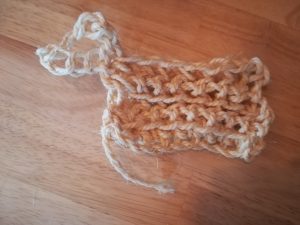 Create your own sisal sponge to scrub yourself in bath or in the shower. You can easily crochet a cloth of sisal rope. Ideal for a good scrub in the bath or in the shower! What is so ecological about this sponge? If it’s worn, just throw it in the compost bin, because sisal is a natural product …
Create your own sisal sponge to scrub yourself in bath or in the shower. You can easily crochet a cloth of sisal rope. Ideal for a good scrub in the bath or in the shower! What is so ecological about this sponge? If it’s worn, just throw it in the compost bin, because sisal is a natural product …
- Cotton sanitary napkins. Yes, here we go… I still notice a lot of embarrassment in women when I start about this subject. But you have to consider how much waste we produce in a woman’s life as a result of our menstruational cycle. P
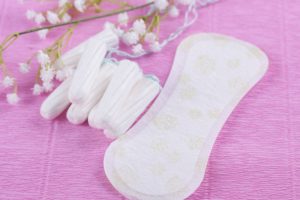 re-packaged sanitary napkins are packaged in plastic we discard. The sanitary napkin itself consists of all kinds of processed fabrics, with added smells and chemicals to bleach them. The question is whether we want so many chemicals in that zone of our body ?! And after we’ve used them, they all end up in the dustbin …
re-packaged sanitary napkins are packaged in plastic we discard. The sanitary napkin itself consists of all kinds of processed fabrics, with added smells and chemicals to bleach them. The question is whether we want so many chemicals in that zone of our body ?! And after we’ve used them, they all end up in the dustbin …
Fortunately, there is also a sustainable alternative for this. And no, it’s not dirty and filthy …
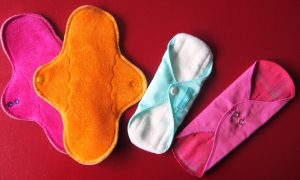 You can buy cotton sanitary towels in various ecological stores. In different cheerful colors, sizes and thicknesses. This sanitary napkin is fixed in your panties with press studs on both wings. After use you immediately rinse it out and after that you can simply wash it with other clothing, at 40°C. Especially when you use it in combination with the menstrual cup (alternative to tampons), with this washable sanitary napkin you should not be afraid of creating a hopeless mess.
You can buy cotton sanitary towels in various ecological stores. In different cheerful colors, sizes and thicknesses. This sanitary napkin is fixed in your panties with press studs on both wings. After use you immediately rinse it out and after that you can simply wash it with other clothing, at 40°C. Especially when you use it in combination with the menstrual cup (alternative to tampons), with this washable sanitary napkin you should not be afraid of creating a hopeless mess.
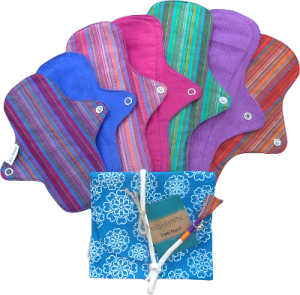 I sewed my sanitary napkins myself (patterns can be found on the internet): at the bottom a layer of stiff cotton that doesn’t slide too easily in your panties, then a layer of air-permeable plastic foil (the type you can use in the microwave), then two layers of absorbent terry (cut from old worn towels) and on top a nice soft layer of organic cotton (cut from a biocotton towel). And what stroke me? Much less sweaty and bad odors! I never ever want to change my cotton sanitary napkins again for the industrial, pre-packaged version. You can also find beautiful bags in which you can take sanitary towels in your handbag and even waterproof bags to store used sanitary towels when you are away from home and need to change your sanitary napkins. Since I always use it in combination with the menstrual cup, I have never had a situation in which I was away from home and needed to change my sanitary napkin.
I sewed my sanitary napkins myself (patterns can be found on the internet): at the bottom a layer of stiff cotton that doesn’t slide too easily in your panties, then a layer of air-permeable plastic foil (the type you can use in the microwave), then two layers of absorbent terry (cut from old worn towels) and on top a nice soft layer of organic cotton (cut from a biocotton towel). And what stroke me? Much less sweaty and bad odors! I never ever want to change my cotton sanitary napkins again for the industrial, pre-packaged version. You can also find beautiful bags in which you can take sanitary towels in your handbag and even waterproof bags to store used sanitary towels when you are away from home and need to change your sanitary napkins. Since I always use it in combination with the menstrual cup, I have never had a situation in which I was away from home and needed to change my sanitary napkin. 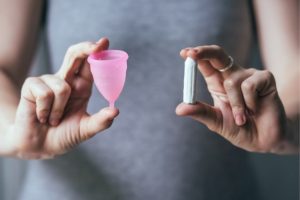 Menstrual cup. This silicone ‘cup’ is a fantastic alternative to the chlorine-bleached tampons made of cotton that has been worked with tough chemicals. The cup is very pliable, so you can easily insert it. After a few hours, take the cup out again, empty it in the toilet, rinse it and put it back in again. The only awkward moment is when you are in a public toilet, where the washbasin is not in the toilet cubicle. In that case, you can pee on and in the cup to rinse it; urine is sterile, so this doesn’t do any harm. Make sure the cup is rinsed before you re-insert it.
Menstrual cup. This silicone ‘cup’ is a fantastic alternative to the chlorine-bleached tampons made of cotton that has been worked with tough chemicals. The cup is very pliable, so you can easily insert it. After a few hours, take the cup out again, empty it in the toilet, rinse it and put it back in again. The only awkward moment is when you are in a public toilet, where the washbasin is not in the toilet cubicle. In that case, you can pee on and in the cup to rinse it; urine is sterile, so this doesn’t do any harm. Make sure the cup is rinsed before you re-insert it.
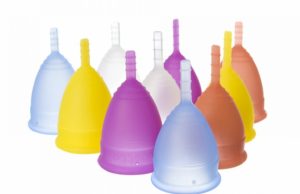 In the beginning you need a bit of time to get used to the cup and to find the right way insert to the cup. But after a few times you get the hang of it easily. There are 2 sizes: for not-so-young women and women who have already given birth and for young women who have not yet given birth. The cup has a stalk that you can cut to size and that you can use to easily extract the cup. I completely cut off the stalk of my cup because it annoyed me. And that works fine too. In the meantime I have been using my cup for about seven years and I am still very satisfied. The cup can last for many years and only seems to wear out as a result of boiling it. At the beginning of a new menstrual period it is recommended to first boil the cup before you use it. I forgot a few times that the pot with the cup in boiling water was on the stove. Result: all the water evaporated… Only after the third time I left the pot on the stove, the cup was broken; the two previous times it had survived perfectly well!
In the beginning you need a bit of time to get used to the cup and to find the right way insert to the cup. But after a few times you get the hang of it easily. There are 2 sizes: for not-so-young women and women who have already given birth and for young women who have not yet given birth. The cup has a stalk that you can cut to size and that you can use to easily extract the cup. I completely cut off the stalk of my cup because it annoyed me. And that works fine too. In the meantime I have been using my cup for about seven years and I am still very satisfied. The cup can last for many years and only seems to wear out as a result of boiling it. At the beginning of a new menstrual period it is recommended to first boil the cup before you use it. I forgot a few times that the pot with the cup in boiling water was on the stove. Result: all the water evaporated… Only after the third time I left the pot on the stove, the cup was broken; the two previous times it had survived perfectly well!
A cup costs about 30 €. A lot more expensive than a box of tampons. But if you add up how many boxes of tampons you use in a period of roughly 10 years, then the balance will take a firm turn … And above all: this cup does not cause any waste!- Bamboo earspoon. Do you have any idea how many cotton swabs you use and throw away in a lifetime? That must be a lot! Fortunately there is an alternative that is reusable: the ear spoon. At the pharmacist you can find them in metal with plastic.
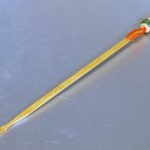 But they also exist in bamboo. Bamboo is a less cold material so I find it much more pleasant to use. After each use you rinse it and you can store it again in your cupboard.
But they also exist in bamboo. Bamboo is a less cold material so I find it much more pleasant to use. After each use you rinse it and you can store it again in your cupboard.
Please be careful. If you go too deep with these ear spoons, you can hurt yourself. - Don’t use any soap or shampoo. How to live without shampoo, you can read here . As long as you’re not dirty, it’s not necessary to wash your skin with soap every day. Freshen your body in the morning with fresh water and dry. That’s all. Dirty hands are best washed with soap, preferably no liquid soap in a plastic container, but a block of ecological soap. This way you save a lot of plastic bottles of shampoo and soap!
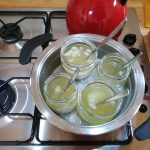 Make your own deodorant and bodylotion. You can easily make your own deodorant and bodylotion, based on coconut oil, almond oil, yoyoba oil, sodium bicarbonate (baking soda) and cornstarch. You can use some essential oil to add a nice scent and you’re read! Store it in a glass container. You can find many recipes on internet.
Make your own deodorant and bodylotion. You can easily make your own deodorant and bodylotion, based on coconut oil, almond oil, yoyoba oil, sodium bicarbonate (baking soda) and cornstarch. You can use some essential oil to add a nice scent and you’re read! Store it in a glass container. You can find many recipes on internet.- Use cotton handkerchiefs instead of paper ones.
